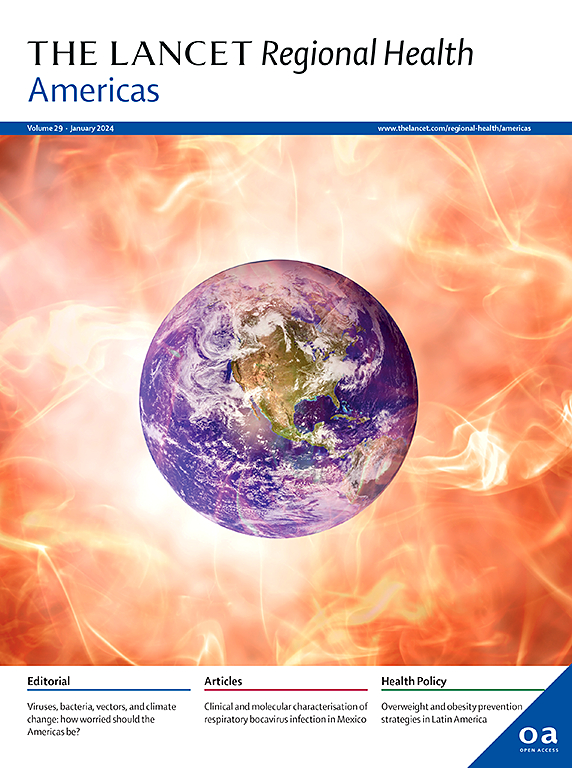Introduction, establishment, and distribution of Aedes aegypti and dengue in a temperate capital of Brazil: a retrospective surveillance-based study
IF 7
Q1 HEALTH CARE SCIENCES & SERVICES
引用次数: 0
Abstract
Background
Dengue is spreading to southern latitudes in Brazil, where the temperate climate was once a barrier to the primary vector, Aedes aegypti. In this study, our objective was to reconstruct the introduction, establishment, and subsequent expansion of Ae. aegypti and dengue in Porto Alegre, the southernmost state capital of Brazil, located in Rio Grande do Sul state.
Methods
This ecological study used entomological and epidemiological surveillance data and official reports obtained from municipal health authorities of Porto Alegre, from 2001 to 2021. Descriptive analyses were employed, supplemented by space-time scan statistics to identify high-risk vector abundance and dengue case clusters.
Findings
Ae. aegypti was first detected in Porto Alegre in 2001, spreading citywide by 2016. The first autochthonous dengue case was recorded in 2010, and by 2021 the disease was detected in 78% of the neighbourhoods. DENV-1 was the dominant serotype and most cases occurred among people aged 20–59. Clusters of vectors and dengue cases were more frequent during summer and autumn, but a few were also identified during winter. High-risk clusters for vectors were more frequent in the Partenon and Northwest regions and for dengue in the East, Centre, Partenon and South.
Interpretation
Ae. aegypti successfully established and spread within a temperate city in Brazil. The presence of vectors, a susceptible population and socio-environmental characteristics conducive to mosquito proliferation resulted in autochthonous transmission of dengue fever after the continuous introduction of imported cases. The climatic barrier to dengue transmission in the south of Brazil has shifted southward, coinciding with the colonisation of Ae. aegypti and the emergence of dengue in recent years in Porto Alegre.
Funding
Generalitat de Catalunya, European Commission, and Conselho Nacional de Desenvolvimento Científico e Tecnológico (CNPq).
巴西温带首都埃及伊蚊和登革热的传入、建立和分布:基于监测的回顾性研究
登革热正在向巴西的南纬地区蔓延,那里的温带气候曾经是主要媒介埃及伊蚊的一个障碍。在这项研究中,我们的目的是重建Ae的引入,建立和随后的扩展。埃及伊蚊和登革热在巴西最南端的州首府阿雷格里港,位于巴西南大德州。方法利用2001 - 2021年阿雷格里港市卫生部门的昆虫学和流行病学监测数据和官方报告进行生态学研究。采用描述性分析,辅以时空扫描统计,确定高危媒介丰度和登革热病例群。埃及伊蚊于2001年首次在阿雷格里港被发现,到2016年在全市蔓延。2010年记录了第一例本地登革热病例,到2021年,在78%的社区中发现了该病。DENV-1为主要血清型,以20 ~ 59岁人群为主。媒介聚集和登革热病例在夏季和秋季更为频繁,但在冬季也发现了少数病例。媒介高危聚集在帕特农和西北地区更为频繁,登革热高危聚集在东部、中部、帕特农和南部地区更为频繁。埃及伊蚊成功地在巴西一个温带城市建立并传播。由于存在病媒、易感人群和有利于蚊子繁殖的社会环境特征,在不断输入病例之后,登革热发生了本地传播。巴西南部阻碍登革热传播的气候屏障已向南转移,与伊蚊的定居一致。埃及伊蚊和近年来在阿雷格里港出现的登革热。资助加泰罗尼亚政府、欧盟委员会和国家环境保护委员会Científico e Tecnológico (CNPq)。
本文章由计算机程序翻译,如有差异,请以英文原文为准。
求助全文
约1分钟内获得全文
求助全文
来源期刊

Lancet Regional Health-Americas
Multiple-
CiteScore
8.00
自引率
0.00%
发文量
0
期刊介绍:
The Lancet Regional Health – Americas, an open-access journal, contributes to The Lancet's global initiative by focusing on health-care quality and access in the Americas. It aims to advance clinical practice and health policy in the region, promoting better health outcomes. The journal publishes high-quality original research advocating change or shedding light on clinical practice and health policy. It welcomes submissions on various regional health topics, including infectious diseases, non-communicable diseases, child and adolescent health, maternal and reproductive health, emergency care, health policy, and health equity.
 求助内容:
求助内容: 应助结果提醒方式:
应助结果提醒方式:


